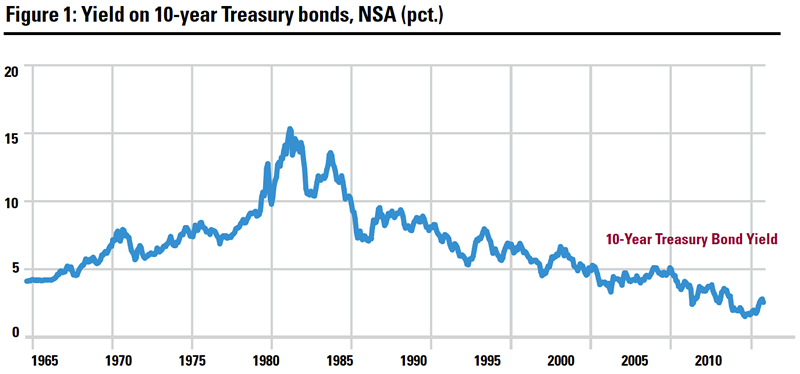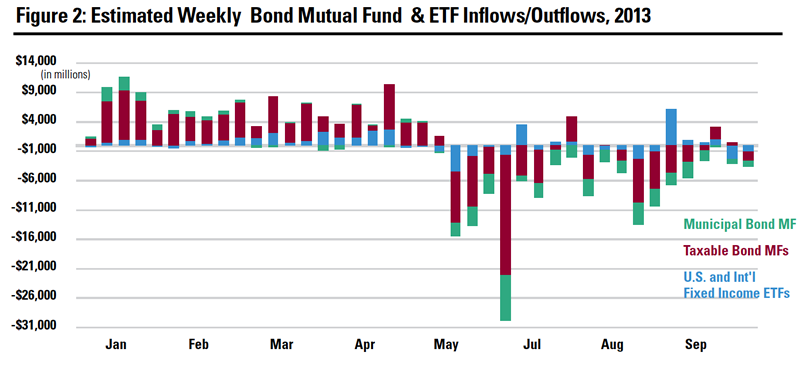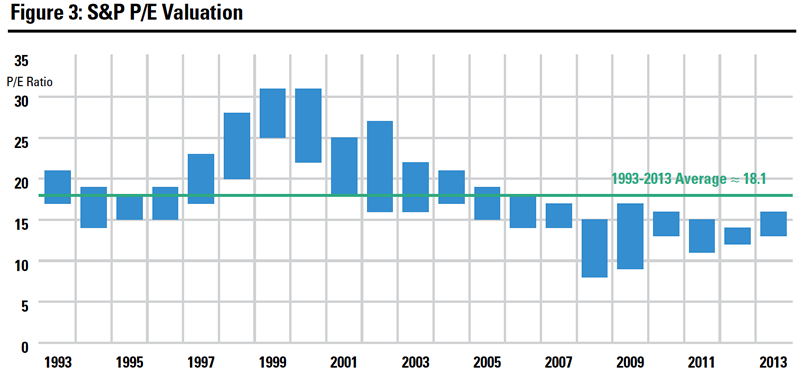What’s an Investor To Do?
 As we begin the New Year, Maryland investors find themselves in a bit of a quandary: where to invest in 2014. There do not appear to be any clear options. The consensus view on Wall Street is that interest rates will move higher. If correct, that would mean their more safe investments, bonds, are headed for another difficult year. Stocks are up significantly since the financial crisis and appear fully valued. Perhaps the year will not be kind to stocks either. Cash is yielding nothing and unless the Fed has a drastic change of heart, that is not expected to change. So, what’s an investor to do in this environment?
As we begin the New Year, Maryland investors find themselves in a bit of a quandary: where to invest in 2014. There do not appear to be any clear options. The consensus view on Wall Street is that interest rates will move higher. If correct, that would mean their more safe investments, bonds, are headed for another difficult year. Stocks are up significantly since the financial crisis and appear fully valued. Perhaps the year will not be kind to stocks either. Cash is yielding nothing and unless the Fed has a drastic change of heart, that is not expected to change. So, what’s an investor to do in this environment?
The bond market is probably not the answer as we are most likely headed for another difficult year. The Quantitative Easing program should end in 2014 and the Fed may begin to seriously contemplate increasing the Fed Funds rate. The mere threat of tapering the QE program in 2013 caused a violent reaction as the yield on the 10-year Treasury spiked from 2% in June to 3% in September. The 10-year Treasury began 2013 yielding 1.76%. An upward bias to yields of most maturities longer than 2 years persisted throughout 2013 and many pundits suggest 2014 will likely be no different. Investors are not used to losing money in their bond investments. When yields are moving lower, bond prices move higher and vice versa. As we can see from the chart of the 50-year history of the 10-year Treasury yield, bond investors have experienced a long and strong bull market since about 1982. But the bull market in bonds has to come to an end at some point, as yields cannot go to zero because investors require a return on their investment. Lending money to the government at 1.40% for 10 years, as was the case in July of 2012, is unattractive at best. In fact, not only were real rates of return (the yield minus the inflation rate) negative but the equity market, as measured by the S&P 500, provided a higher yield.
 If the yield on the 10-year Treasury increases by 1% during 2014, that will work out to a drop in that bond’s price of roughly 9%. If the yield on that same bond increases by 2% next year, the price will drop by 16%. Given the incredibly long run of this bull market in bonds, many have forgotten that money can be lost in this asset class. 1999 and 1994 were the last years when bonds experienced a negative return for investors. During 1994, the yield on the 10-year ranged between roughly 6% and 8%. During 1999, the yield ranged between 5% and 6.5%. Given today’s lower nominal yield level, the price volatility will be higher because, all things being equal, the lower the yield and longer the maturity the more leveraged is the price of a bond to interest rate movements. For example, if one felt strongly that interest rates were going to move lower in a meaningful way, the best way to invest for that forecast would be to purchase a zero coupon bond with the longest maturity available.
If the yield on the 10-year Treasury increases by 1% during 2014, that will work out to a drop in that bond’s price of roughly 9%. If the yield on that same bond increases by 2% next year, the price will drop by 16%. Given the incredibly long run of this bull market in bonds, many have forgotten that money can be lost in this asset class. 1999 and 1994 were the last years when bonds experienced a negative return for investors. During 1994, the yield on the 10-year ranged between roughly 6% and 8%. During 1999, the yield ranged between 5% and 6.5%. Given today’s lower nominal yield level, the price volatility will be higher because, all things being equal, the lower the yield and longer the maturity the more leveraged is the price of a bond to interest rate movements. For example, if one felt strongly that interest rates were going to move lower in a meaningful way, the best way to invest for that forecast would be to purchase a zero coupon bond with the longest maturity available.
As the consensus forecast for 2014 is for higher yields, investors have already started to move. Bond mutual funds are witnessing what can only be described as massive withdrawals (see table). These withdrawals began in earnest when the Fed began openly discussing tapering the QE program. Selling bond mutual funds before individual bond holdings is a very good strategy. With an individual bond, investors typically receive a fixed coupon and maturity date. Bond mutual funds provide neither. These two elements of an individual bond provide some assurances to investors that bond funds cannot provide. A $25,000 investment in an individual bond will provide the investor with two important outcomes: a fixed return until maturity (3% per year for example) and the face amount of the bonds at maturity (in this case $25,000). Assuming no credit default, no matter what happens to yields between the time of purchase and maturity, investors will get their money back at maturity with a fixed annual rate of return along the way. In contrast, a $25,000 investment in a bond fund can go up or down in value and yield on any given day. There are no assurances at all that investors will get their original investment back or what rate of return they might earn. In a bond bull market, bond mutual funds are perfectly good investments. We will see how they hold up in a rising interest rate environment.

For Maryland residents, Maryland municipal bonds offer an excellent relative value. Yields on Maryland bonds for most of 2013 were actually higher than yields on the equivalent Treasury. Of course, the added bonus Maryland bonds provide to Maryland residents is they do not pay federal or state income tax on the interest. Not only was the nominal yield higher but when one considers the after tax benefits, municipal bonds were far more attractive. That situation remains in place today. Due to the relatively high tax rate in Maryland, demand for Maryland bonds is typically very high making them hard to find. Other states that are triple-A-rated may offer equal or better after-tax yields and there are more bonds from which to choose. Municipal bonds, however, are subject to the same issues as other bonds, so investors need to analyze these securities carefully.
Although bonds could be the least attractive asset class in 2014, cash is not far behind. At least with cash reserves, there is no real risk to losing money. Banks and investment firms that manage most of the money market investments are very well positioned to keep money market funds safe. We remember the terrible experience the financial crisis created in the money market industry. Several local firms had to inject hundreds of millions of dollars into their money market funds to keep their prices at $1. In a few well-known specific examples, the $1 price was broken and investors lost money in their money market investments. New regulations make a repeat of this situation highly unlikely. Money market funds, though, are not paying investors anything. This is the equivalent of putting your money under the mattress. With no return, inflation eats away at the value of the investment.

As we begin to witness what could be the end of a huge bull market in bonds, stocks are facing issues of their own. Outside of the obvious (politics, disappointing economic growth, global debt, etc.), valuation could be the most difficult obstacle of all. The valuation of the overall market is at a critical threshold. As you can see from the chart, the price-earnings (P/E) multiple on forward operating earnings of the S&P 500 is at the high end of the range experienced since the financial crisis. Since 1922, the market has averaged a P/E multiple of approximately 16 times forward earnings. For long periods of time, however, the market tends to settle into a P/E range with which it is comfortable. Typically, some kind of significant event (good or bad) will shift the multiple to a new range. By way of example, we can look at two distinct periods of time to illustrate this point. In the 1970’s, inflation became a significant problem. Because of this, the market took the range for the P/E multiple from average levels all the way down to high single digits. For a decade, the market went nowhere as the P/E multiple contracted to this low level. In the 1990’s, the US economy experienced the longest uninterrupted economic expansion since World War II. For that and other reasons, investors expanded the P/E multiple well beyond anything normal to greater than 30 times earnings.
The financial crisis of 2008 and 2009 brought with it a significant and dramatic resetting of the P/E multiple. Earnings for the S&P 500 dropped by 30% from a peak of $89 in 2007 to a trough of $62.64 in 2009 (see table). The market, however, dropped over 50% from peak to trough, effectively lowering the P/E multiple from 16.5 before the crisis to 13.3 as the crisis abated. Earnings recovered relatively quickly. By 2011, earnings of the S&P 500 had already exceeded the 2007 peak. The market, however, was not to reach the 2007 peak until the spring of 2013. Investors have not been willing to pay higher P/E multiples for current earnings streams because of all of the global financial issues that the crisis created. Currently, the P/E multiple is at the high end of this new range established after the crisis.
 So, the market is now at a crossroads: either the P/E multiple will remain within the post-crisis range or it will begin to reset to a higher range. Should the market remain within the current range, the best investors can hope for is returns that roughly equate to the level of earnings growth. According to FactSet Research, the consensus view for 2014 and 2015 earnings growth for the S&P500 is 9% and 10%, respectively. Given that we are currently trading at the high end of the P/E multiple range, it is very likely that if earnings expectations begin to come down investors would experience a P/E multiple contraction. It would then follow that stock returns could be in for a below-average year. If, however, investors reset the P/E multiple range higher, closer to its “normal” range in the high teens, we could see significant upside from current levels. For this to occur, we would need a much stronger economy that would drive earnings higher than the consensus expectations. Given the current economic backdrop, it seems unlikely that we will be breaking out of this 2% real GDP level for a while.
So, the market is now at a crossroads: either the P/E multiple will remain within the post-crisis range or it will begin to reset to a higher range. Should the market remain within the current range, the best investors can hope for is returns that roughly equate to the level of earnings growth. According to FactSet Research, the consensus view for 2014 and 2015 earnings growth for the S&P500 is 9% and 10%, respectively. Given that we are currently trading at the high end of the P/E multiple range, it is very likely that if earnings expectations begin to come down investors would experience a P/E multiple contraction. It would then follow that stock returns could be in for a below-average year. If, however, investors reset the P/E multiple range higher, closer to its “normal” range in the high teens, we could see significant upside from current levels. For this to occur, we would need a much stronger economy that would drive earnings higher than the consensus expectations. Given the current economic backdrop, it seems unlikely that we will be breaking out of this 2% real GDP level for a while.
The market, therefore, will most likely continue to pay below-average P/E multiples, given all of the pressures on the stock market. In this environment, stocks do not appear to have much near- to intermediate-term upside. We are expecting below-average returns in the market in 2014. In this type of environment, dividend paying stocks tend to perform better than non-dividend paying stocks. Moreover, stocks with higher yields would be more attractive, as a large percentage of the expected return in a low-return environment would come from the dividend. For example, if the expectation is for a five to eight percent return, stocks that yield four percent will provide a very large portion of the expected return. There are some Maryland-based companies worth taking a look at. Bethesda-based Lockheed Martin (LMT) yields 4%. Rockville-based Washington Real Estate Investment Trust (WRE) yields 4.5%. Columbia-based Corporate Office Properties (OFC) yields 4.5%.

US equities appear to be the best investment alternative. Even though we are only anticipating single digit returns for 2014, that should prove to be better than any other asset class. International equities may offer the best relative value. Emerging markets are depressed and Europe is just coming out of a long, deep recession. Even China has been affected by the global economic slowdown as its growth rate has slowed from around 11% to 7%. Keeping in mind that international markets tend to be more volatile than the US market, international stocks may offer better returns in 2014 as countries and regions begin their recovery.
For 2014, there is a very good chance we will experience another year of rising interest rates. Individual bonds are, therefore, preferred over mutual funds. In addition, investors will generally want bonds with higher coupons and shorter maturities to avoid the large potential losses possible holding lower coupon, longer maturity bonds. In 2014, limiting the damage in bonds might be the best strategy. As has been the case for a few years, cash returns should be non-existent for most of 2014.
So what is an investor to do in 2014? Focus on dividend paying stocks with low valuations, lower your expectations, beware of bond funds and cash and have an eye toward international markets.
—as published in CFA Society Baltimore’s annual Baltimore Business Review



